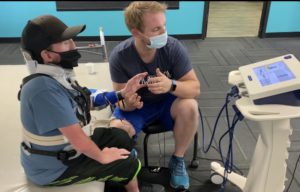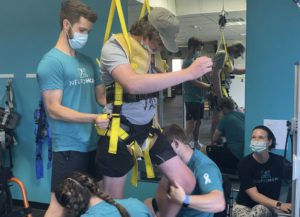NeuroHope’s Speech at Indiana Spinal Cord and Brain Injury Research Conference
NeuroHope Executive Director Chris Leeuw was one of seven speakers at the 2018 Indiana Traumatic Spinal Cord and Brain Injury Research Conference, held April 18th at the IU Health Neuroscience Center in downtown Indianapolis.
The annual conference is sponsored by the Indiana Department of Health to showcase projects that have been made possible thanks to support from the Indiana Spinal Cord and Brain Injury Research Fund.
Leeuw’s talk focused on NeuroHope’s expansion and the mission to provide affordable, activity-based therapy to people living with and recovering from neurologic injury. He also discussed NeuroHope’s recent invitation to join the Christopher and Dana Reeve Foundation NeuroRecovery Network (NRN), and the research that is collected at NRN sites across the U.S.
Full transcription of the presentation:
“Good afternoon! My name is Chris Leeuw, Director of NeuroHope.
We are honored and thankful to share the NeuroHope story with everyone. This presentation will be different than others today, because the support we received from the Spinal Cord and Brain Injury Research Fund was not STRICTLY to fund research. Data collection is a part of what we do, but the primary purpose of the two-year grant we received has been to help our charity NeuroHope expand its very specific mission: to make long-term therapy and exercise programs available for people recovering from traumatic injury after insurance expires, and to do so in a way that is affordable and accessible for the patients that need it.
NeuroHope openedn in 2015 in a part-time gym with the help of the University of Indianapolis Krannert School of Physical Therapy. We understood first-hand that it takes a long time to recover from most neurologic injuries. And, we understood that since healthcare is dictated by insurance reimbursement, patients are discharged from inpatient rehab too soon. Sometimes, discharge is within a matter of weeks, after which, patients are given a limited amount of outpatient PT/OT visits to continue their recovery, which is simply not enough. It is not enough time. It is not enough access.
I lived through the process as a patient. In 2010 I suffered an incomplete C4 spinal cord injury that initially left me a total quadriplegic, paralyzed from the neck down. I’m standing here today because my injury turned out to be less severe than many. I was very fortunate in my recovery. But, even in my situation it to took two years of daily, aggressive therapy to maximize my recovery. I was at the Rehabilitation Hospital of Indiana for my inpatient stay, where I had outstanding care. I did not want to leave. I stayed there for 8 weeks, which is much LONGER than most patients, because I was showing slow signs of progress. But, when my time there expired I was still was mostly paralyzed, and I had to leave continue my rehab out of state.
Within the first year of a spinal cord injury (SCI), medical costs can approach 1 million dollars. Healthcare costs continue to rise, and as a result, inpatient days have become more limited. In the 1970’s the average stay following SCI was 98 days. Today, that number has shrunk to just 35 days.
In year two, and every year after, medical costs may reach $100,000 per year. One in four discharged patients are admitted back into the healthcare system because they sit at home and secondary complications that come hand-in-hand with neurologic injury (pressure sores, contracture, bone-density, etc.) kick in. Outpatient therapy allowances are shrinking as well. Insurance companies allow an average of 21.5 visits per year for outpatient physical and occupational therapy. So, we’re faced with a great irony. At a time when rehabilitative advances are happening faster and faster, adequate access to the best resources is more difficult to come by.
At NeuroHope, we have a different, 4-stage vision.
We do everything we can to complete the continuum of care. After a patient is discharged, instead of a two-stage process, we add a third stage. By providing care at affordable, private-pay-rates, the third stage involves a comprehensive approach to extended rehabilitation so patients can maximize their recovery in the critical first two years after injury. Then we add a 4th stage for chronic injuries that can blend personal training and wellness programs to help patients maintain a healthy quality of life.
This has been our goal. Thanks to support from the ISCBIR Fund, we have been able to increase staff, move to a new gym in the Incrediplex, and increase hours. Most importantly, we have been able to tap into our waitlist and help more people living with paralysis. We are currently seeing about 50 clients, with varying diagnosis, the majority being SCI, TBI.
The expansion has also secured an invitation from the Christopher and Dana Reeve Foundation to join their NeuroRecovery Network (NRN). The NRN is a network of sites that share a similar vision centered around activity-based therapy (ABT). ABT specifically focuses on weaknesses and activating the neuromuscular system below the injury level.
NRN sites collaborate with each other and collect data. Most NRN sites are clinical sites tied to leading rehabilitation hospitals. Other NRN sites, including NeuroHope, are focused more on community fitness and wellness – with an emphasis on making activity-based therapy more widely available in more of a gym setting.
Some of the research collected exclusively at NRN sites involves Neuromuscular Electrical Stimulation (NMES). This looks like normal Electrical Stimulation (E-stim) or FES, but it is much different. NMES is centered around the success of epidural stimulation research. NMES uses different parameters than typical E-stim. The main differences are higher pulse width and frequency, and longer amplitude. NMES tries to trigger beyond the muscle into the nervous system.
We’re proud to be a part of the NRN, although it is a very small part of what we do.
Our primary focus centers on the basic mission of getting people active, out of their chairs, and promoting as much recovery and wellness as possible to improve long-term quality of life. Over the next two years, NeuroHope staff will be working with researchers from the University of Indianapolis to track patient outcome measures, and patient satisfaction. We have also developed a logic model to help track the overall goals of our program.
This strategic plan is important, because our program must remain sustainable. A substantial part of what we do relies on fundraising to help offset the true cost of the care we provide. It’s critical for us to work with providers and healthcare leaders to help complete this continuum of care. And, it’s our hope we can be back a year from now and share our continued success.
Thank you very much.”

